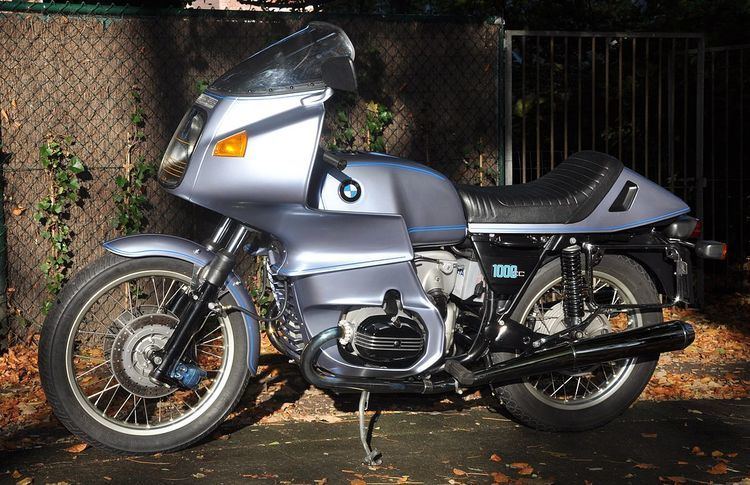Parent company BMW Predecessor BMW /6 | Also called Slash 7 "Airhead" Production 1976–1996 | |
 | ||
Successor BMW K Series, BMW "Oilhead" | ||
BMW R 100, with variant models designated by T, S, CS, RS, RS Classic, RT, RT Classic, R and GS is a BMW motorcycle series, using a two-cylinder four-stroke boxer engine of 980 cc capacity. Model production began in 1976, with a premature shutdown and subsequent restart in 1985, and final completion of the series in 1996.
Contents
- First 7 and second series
- Brakes
- Wheels
- Engine and Drivetrain
- Carburetor
- Suspension
- Ignition
- Pause and Restart
- References
The last of the "airheads," this article also discusses the different /7 models of smaller displacements (R 60, R 75, R 80).
First (/ 7) and second series
The "slash seven" development was an evolutionary change of the BMW 247 engine from the previous "slash six" and initially constituted the R 100 RS (51 kW / 70 PS), R 100 S (only 48 kW / 65 PS), R 100 (44 kW / 60 PS), R 75/7 (37 kW / 50 PS) and R 60/7 (30 kW / 40 hp).
The R 100 RS was the first motorcycle with standard frame fixed full fairing. This innovation was a departure from previous touring fairings, giving birth to the modern Sport touring motorcycle.
Brakes
The R-100 models received a double disc brake in the front wheel. For 1976 to 1979 models the front brake was a pivot caliper ATE disc actuated from the controls via cable to a brake master cylinder under the tank. From 1980 models onwards front brakes were changed to a Brembo fixed caliper brake, and the master cylinder was moved from undertank to the right handlebar. With the introduction of Monolever models in 1986, the Brembo fixed calipers were mounted on the fork tubes. The back brake was initially a drum brake. Starting in the 1978 model year (September 1977), the R 100 RS and RT and S models received a Brembo rear disc brake with fixed caliper on the rear wheel, and from model year 1986 the drum brake returned.
Wheels
The models originally were fitted with wire spoked wheels, but in September 1977 for the 78 model year shifted to an aluminum cast "snowflake" pattern. The initial aluminum wheels were prone to breakage, prompting a BMW recall for replacement.
Engine and Drivetrain
In keeping with the evolutionary development of the Boxer line, the engine was a longitudinal opposed 2-cylinder boxer engine with lower camshaft and overhead valves. Driving the camshaft was a duplex (later simplex) chain with a spring-loaded chain tensioner. The clutch was a single dry plate with cable actuation. A 5-speed manual transmission, with an optional kickstarter for the early models, and shaft drive to the rear wheel completed the drivetrain.
Carburetor
A constant velocity carburetor was supplied by Bing. Starting in 1980, an emissions control system was implemented in various countries, which reduced available horsepower by approximately 10%.
Suspension
The front forks were telescopic with a diameter of 36 mm without gaitors. 1984 and prior had a dual swing arm with two shock absorbers, model year 1986 and after used the BMW monolever, 1988 and after used the BMW paralever.
Ignition
Up to model year 1980, a points type high-voltage capacitor ignition was used. From 1980 onwards, an electronic ignition was fitted.
Pause and Restart
In the 1980s for environmental and marketing reasons, BMW initiated a move to the water-cooled K75 and K100 models to remain competitive with the technical lead of the Japanese motorcycle industry. For this purpose they wanted to give up the production of the "airhead" two-valve boxer models. This decision led to protests from customers and dealers, BMW restarted R100 production, but with modified lower output, and improved torque curve engines with 44 kW (60 hp). They later produced an 800 cc version with 37 kW (50 hp).
Starting in 1985, the road versions were equipped with a single-sided swingarm (Monolever). From 1988 Paralever rear suspension was introduced, first in the GS models R80 GS and R100 GS, and later in the road versions R80 R and R100 R.
